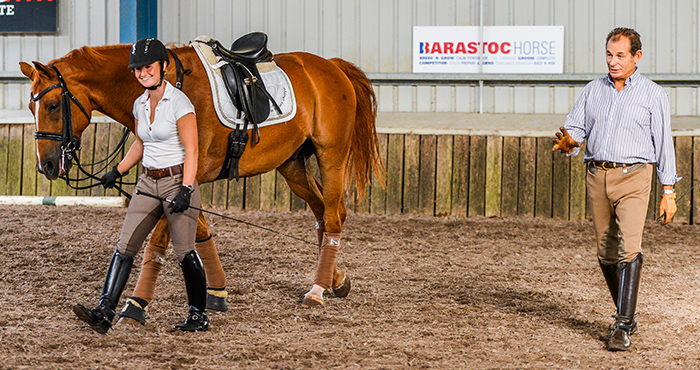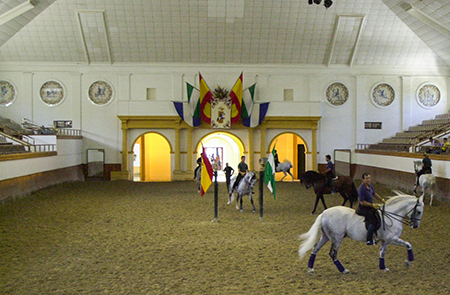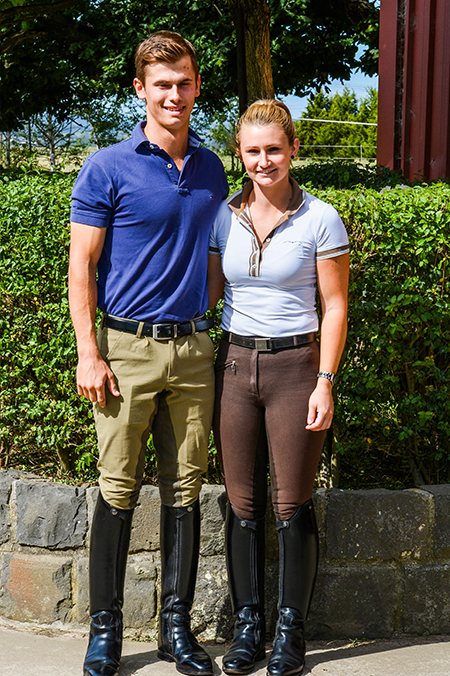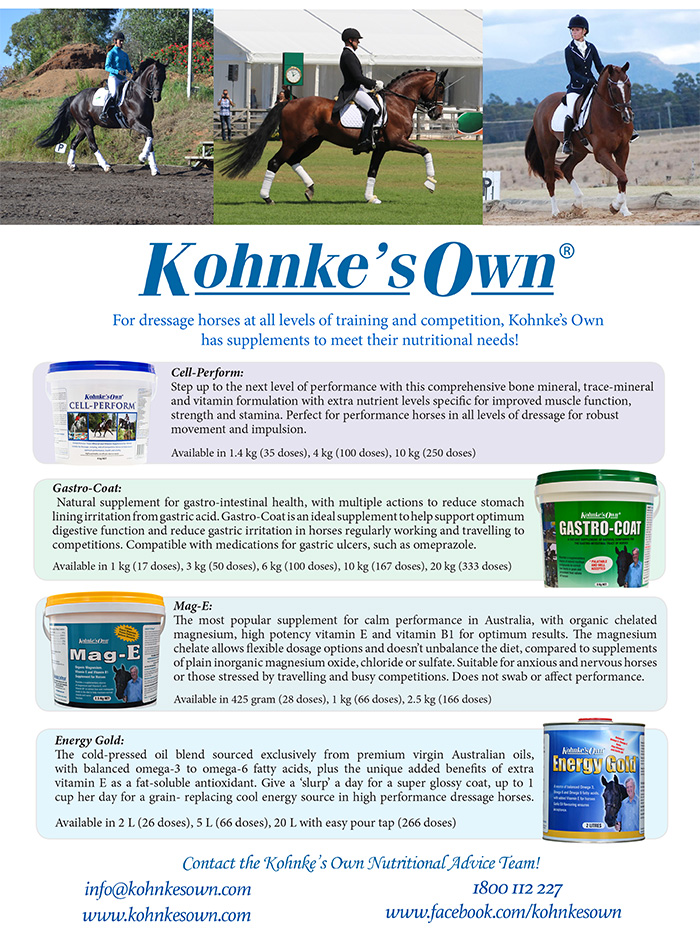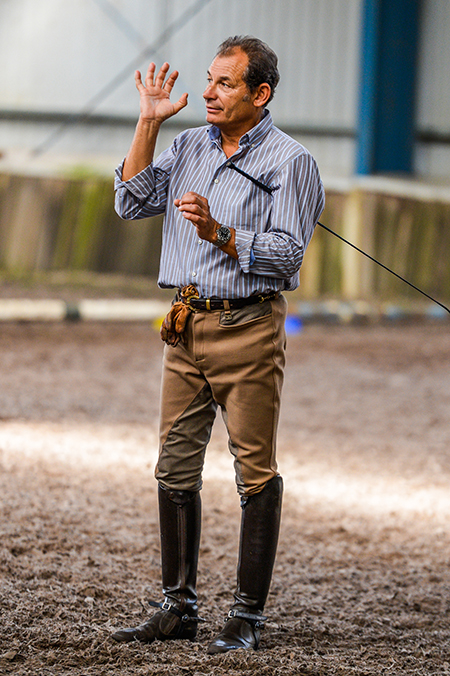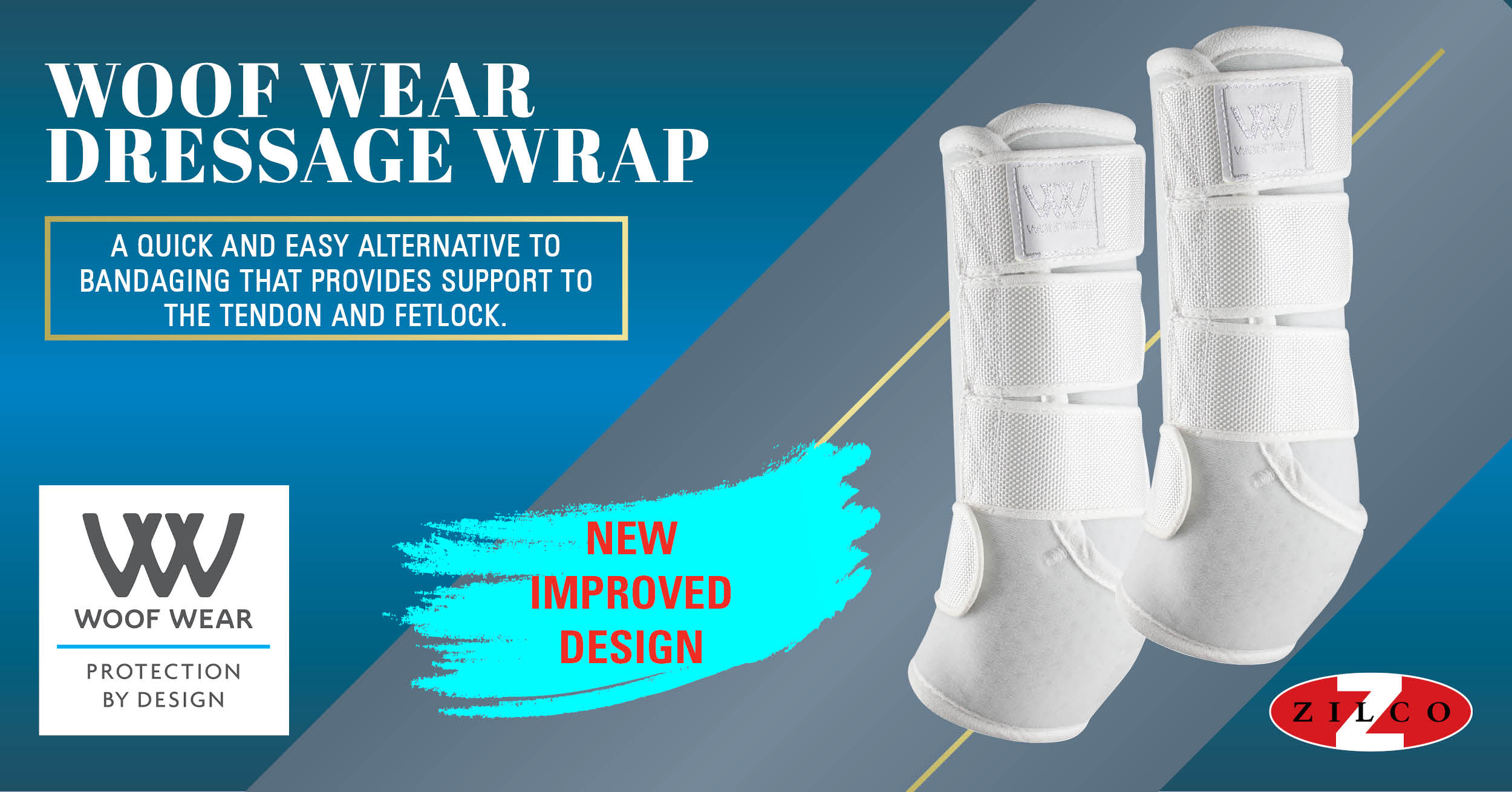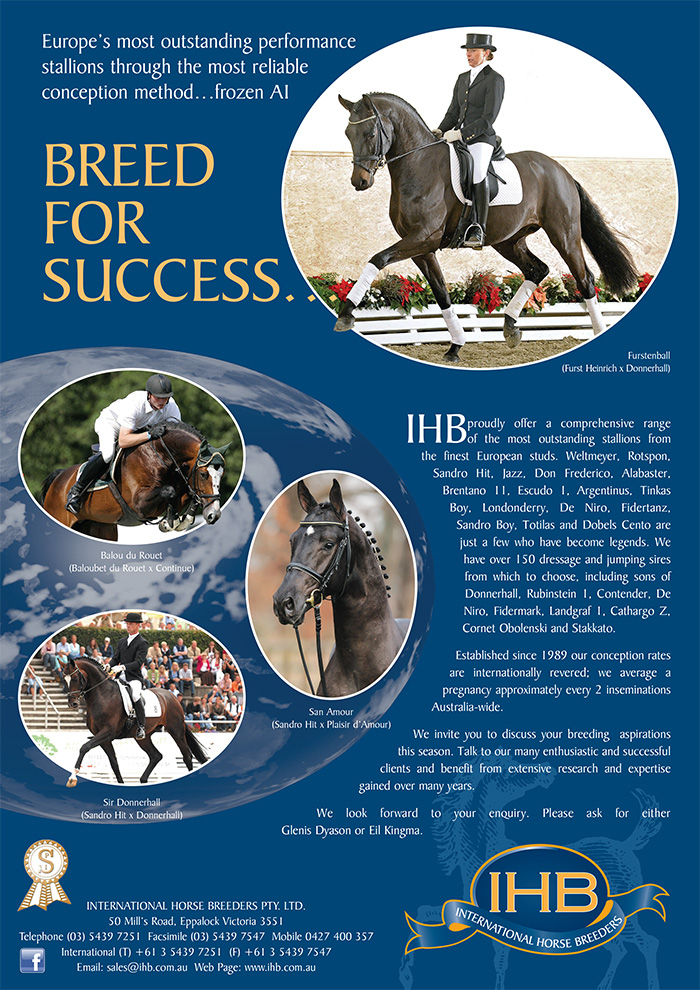It really is one of the great pleasures in life to sit and watch a gifted trainer work with enthusiastic and dedicated and TALENTED young riders. Thus it was at Victoria’s Jesmond Dene, with visiting trainer, Rafael Soto and two of Australia’s rising dressage stars, Alexis Hellyer and Elliot Patterson.
Rafael and Invasor at home at the Royal School in Jerez
Rafael is the manager of the Riding Department at the famed Real Escuela of Andaluza del Arte in Jerez but his work has long combined the presentation of traditional Spanish Equitation with a successful career in international equestrian competition. He first represented Spain at the European Championships of 1995, and was top ten individual placegetter at three consecutive Euro Champs – 1999, 2001 and 2003, where the Spanish team took home team silver. He was in the bronze medal winning team at the 2002 WEG, and the silver medal winning team at the Athens Games where Rafael and his great partner, Invasor placed 8th individually.
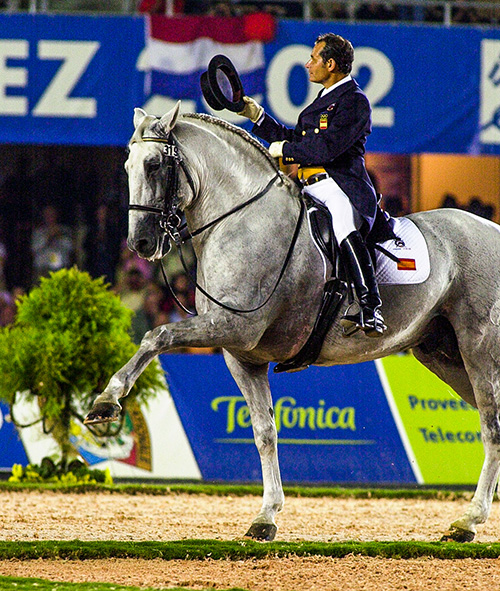
Invasor and Rafael finish their test at the WEG Spanish style
As Alexis Hellyer and Elliot Patterson soon discovered, there’s nothing particularly ‘Spanish’ about Rafael’s approach but he can – and does – produce spectacular improvements with his insistence on having the horse really, really supple before asking for the exercises…
Alexis & Elliot
“The lesson was really good,” Alexis told me, “Not a band aid, actually fixing the problem. It was getting the horse soft and supple and then working that through. Waca tends to go a bit uneven in the passage, and normally I’ve been doubling the right rein, not really knowing what I should be doing, we went back and really made the horse supple, a lot of travers, a lot of shoulder-in, straightness, the horse was really calm, the work wasn’t invasive, there was not a lot of whip at all, just getting him off my leg, accepting my leg…”
next the lesson
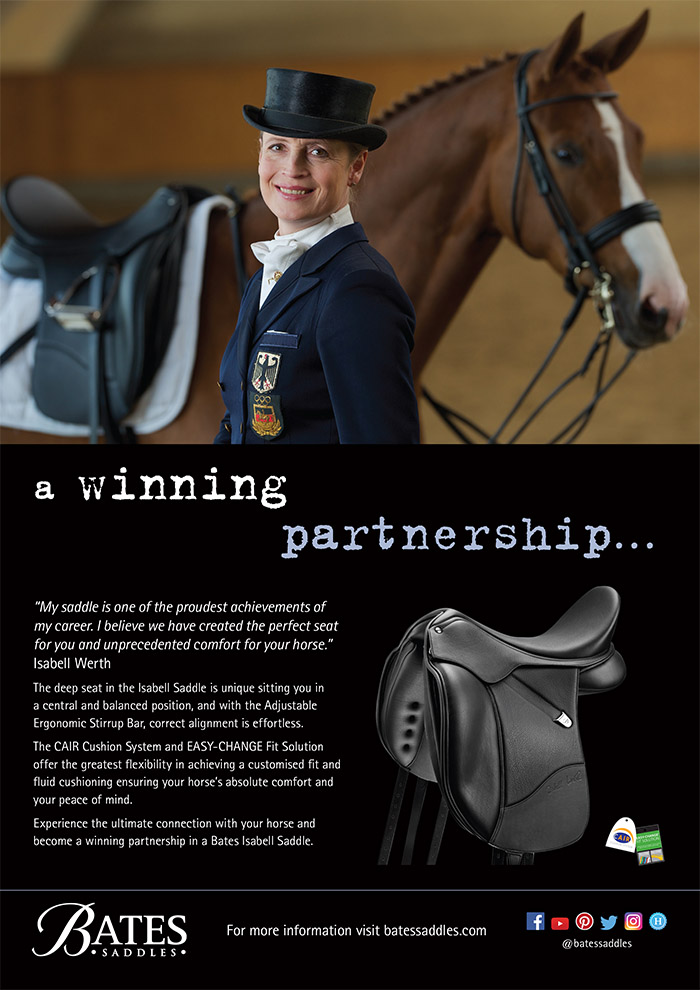
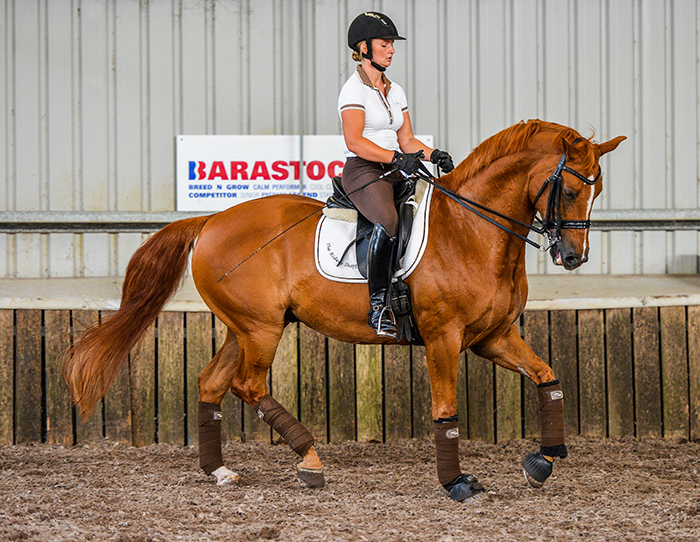
Were you expecting something more exotic and Spanish?
“It wasn’t exotic, it was really basic. Not a lot of test movements, but a lot of suppling and softening, it was really good and he is a lovely guy. Very good explanations of everything, very clear and straight-forward and encouraging and positive. Even when something went a little bit wrong, he was overly positive about the whole thing, and the horses got confidence from him being positive. It was super.”
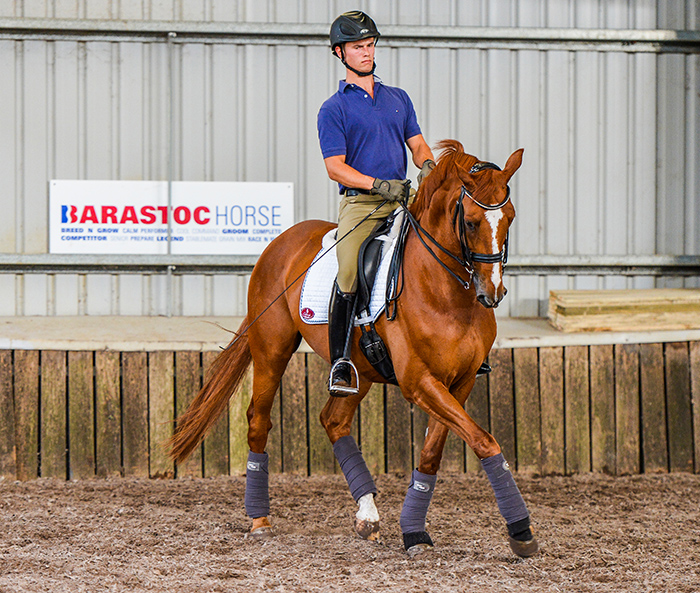
Alexis’ partner, Elliot was also impressed:
“With me, Rafael concentrated on fixing the contact. The horse is very light in the mouth, and it was a matter of getting him to take the contact more, and become more supple in the back, so that he does take the contact down and a little deeper. Usually I tend to hang on and that is a problem I have, I get him too short in the neck – a lot of the work was on the basics, a lot of outside shoulder-in, suppling the back to more of an extreme than what I have been doing. It is good to have someone who can say, yes, go this much further. The final ten minutes of my first session with Rafael, it was just a completely different horse. He was perfectly there in front of me, no irregularity, he was so correct through the back.
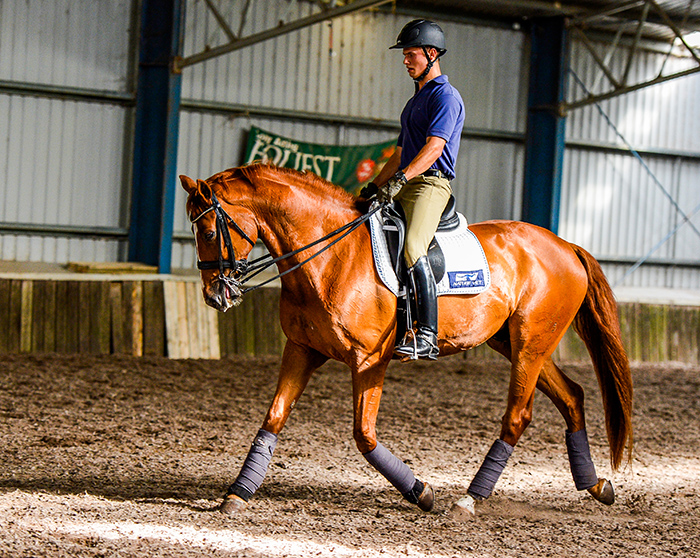
That’s what Rafael said, it starts with the suppleness. Sometimes you get other international coaches who come out here, and they are go, go, go, do this, do this, do this, and he was very much, have a break, go down in the frame, allow the horse to go deep… then come back and we’ll work on your Prix St Georges.”
It was interesting that when Rafael started work with Alexis and Waca, that even in the long frame, he was asking for the lateral bend: ‘bend left, bend right, shoulder-in with a long neck with a low head, now you have a very nice balance.’
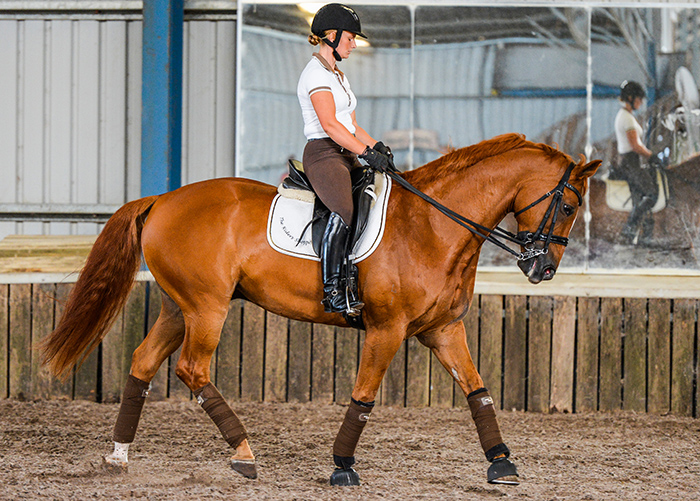
Rafael would mix shoulder-in with leg yield: “Leg yield, bend right, shoulders to the left”, getting the horse active under the rider, “Can you feel that? Can you feel it?”
I guess I can say this because I bred him, but Waca is a bit long and low in the construction department, but with all the bending / suppling, you could see his body changing shape, coming higher in front, into a better frame. Alright, instructors always say don’t shorten the neck when you collect, but Rafael actually gave the rider the technique to achieve this equestrian equivalent of the sound of one hand clapping.
Piaffe work next
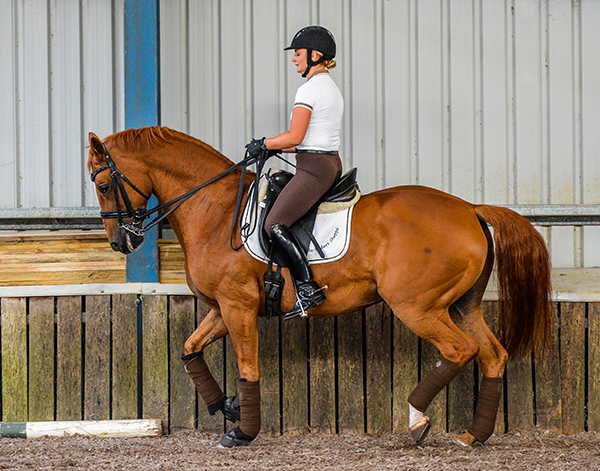
The piaffe work was particularly fascinating. It started with piaffe out of walk, which is fair enough, but then “canter a circle, outside shoulder-in, now transition, canter to piaffe” and wow Waca, they were some super steps!
Rafael sends the pair across the diagonal in medium trot and suddenly there is a new found crispness about the way the horse moves, it’s positive tension at work, it’s exactly what I hoped would happen when I suggested to Alexis that she might enjoy working with Rafael.
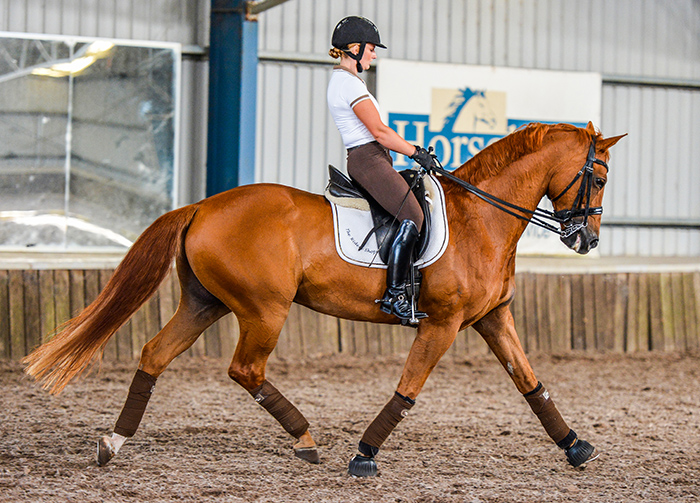
The same thing is happening with Elliot and Leandro, the same balletic dance steps, shoulder-in, outside shoulder-in, travers, renvers, leg yield, and getting the horse into a longer, more natural shape.
Now Rafael takes Waca on the ground, and instantly the horse’s hindlegs are so engaged and active in piaffe. “This coordination is not easy, it is only possible to do it by doing it, now Alexis, you try…”
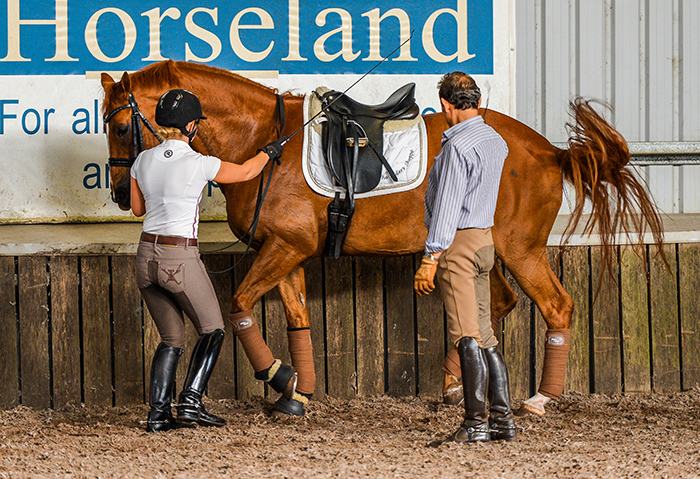
Waca gets a bit excited and there’s a buck and a kick out before he moves forward into some great piaffe. “That was good Alexis, you put him in a hot state of mind, and out of that comes the activity.”
It was a fine finish to a fascinating couple of lessons, and time to sit with Rafael over a glass or two of Fino and some excellent olives, and talk about training and training techniques. Rafael clearly enjoys teaching…
“It is so good to teach young riders who are serious and they try very hard, because this is the future. The experienced riders and trainers must transmit this experience to the younger riders because this is the chain, so the next generations get this culture and this correct way of training. This way of training makes every horse better.”
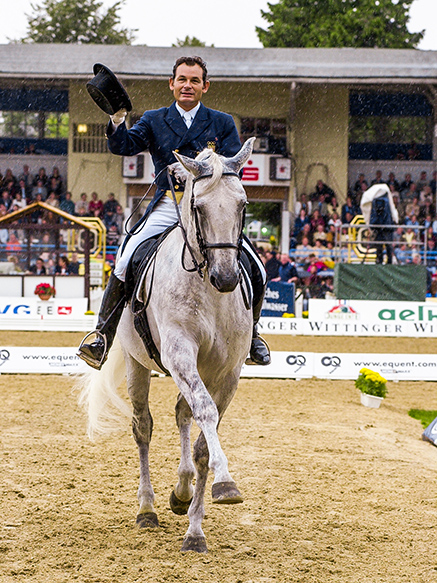
“I have worked with horses all my life. I’ve never stopped training, my father ran an equitation centre, Palma de Mallorca. So I learnt when I was a kid with my dad, and then with Alvaro Domecq who founded the School in Jerez. I was helped by some of the very experienced riders of the School, and then when I started to compete internationally, I had the luck to have very good trainers – Jürgen Koschel and Jan Bemelmans, and then to have the experience of riding three Olympic Games, three World Equestrian Games, five European Championships – there I saw so many good riders and teachers training…”
“I always looked with a view of being open to ideas, so my method is a mixture of many things that I learnt from those people, and from the horses themselves. Jan Bemelmans told me many years ago, that dressage is about learning how to speak with the horse, how to understand from the horses, then they tell you many things.”
“And believe me, I also learn from my pupils. More and more I teach, and less and less I compete, for me it is the time to teach, and from working with different riders and horses, I learn a lot. From being alert to what is happening in this training, I learn new little details.”
It was very interesting what you were talking about canter being the secret to contact, and bringing the horse into piaffe from canter…
“This is my own experience and watching other riders with their horses. I am not the first one to do that. The canter is the more natural gait for the horse. The canter is the gait where the horses get more supple, and more natural. This is why when something doesn’t work in piaffe or passage because the rhythm is uneven, or he is stiff, go to canter and in the canter try and search for the good contact – maybe in that moment you need the travers, outside shoulder-in in canter, or whatever. Put the horse in front of you, it is not only the canter, it is what you do with the canter that makes the good contact come, and the suppleness of the back, and then out of that you search for the passage, or just piaffe.”
“Some horses that are difficult in the piaffe and they get hot or they get very unsure of the piaffe, the canter helps them a lot.’
But it is a hard transition to ride…
“Yeah it’s hard but I can tell you, most of my horses, when they have problems in piaffe, I go to canter, then from the canter, maybe out of a shoulder-in in canter, then instead of going to the trot, I go to piaffe, and they do the steps much more easy. You could see it with Alexis.”
Again it was interesting that you were asking them to maintain the bend in the transition, from trot shoulder-in, to walk shoulder-in…
“It is very important, straightness comes from the shoulder-in. One of the great riders who founded the new Saumur School, Colonel Jean de Saint-Andre and he said riding was just three words: impulsion, calm and straight. When you have this you have everything. And straight is shoulder-in. It could be shoulder-in in or shoulder-in out. It was la Guerinière who created the shoulder-in, centuries ago, and this is fantastic, out of the shoulder-in comes the rest of the lateral work, and this makes the horse straight, in walk, and trot and canter. If you want to have a straight horse with the hind legs under and ready with a contact to do the transition from more to less or less to more, you need to have the shoulder-in.”
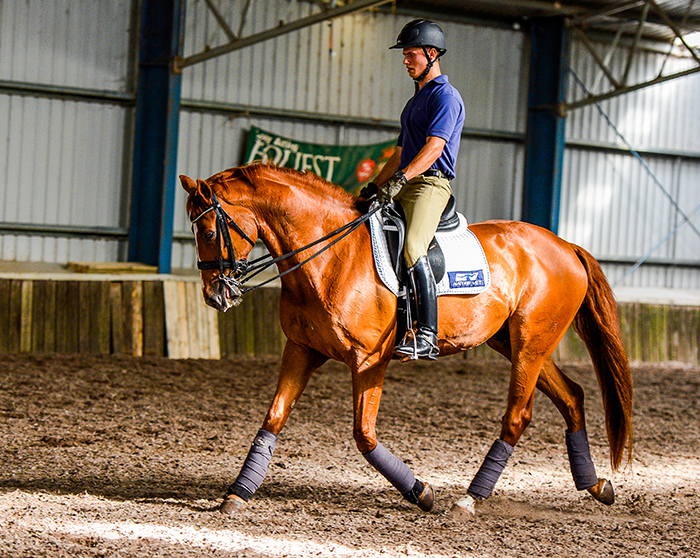
It was interesting when you asked Elliot’s horse to do the medium trot on the diagonal, the off hind was not tracking up, and you had him doing outside shoulder-in to fix the problem…
“Because he was stiff on the outside rein – what to do with that? The left side is the more easy or flexible rein, so what I did is a small circle with outside shoulder-in, and out of that we have more easy contact with the outside rein, and that let Elliot’s hands go forward, and the horse’s neck go forward and the moment the neck goes forward with a good contact, the horse’s back was through – then go! And the horse’s legs were even, the hind leg was in, and the horse was free to go with no problem.”
“In the end, if you study the basic locomotion of the horse it is very, very clear. You see it in nature with horses, they use their neck up or down or wherever they need it, and the hind legs come through and they look wonderful how they move. But if the neck is short and up, or too far down, they can’t do it.”
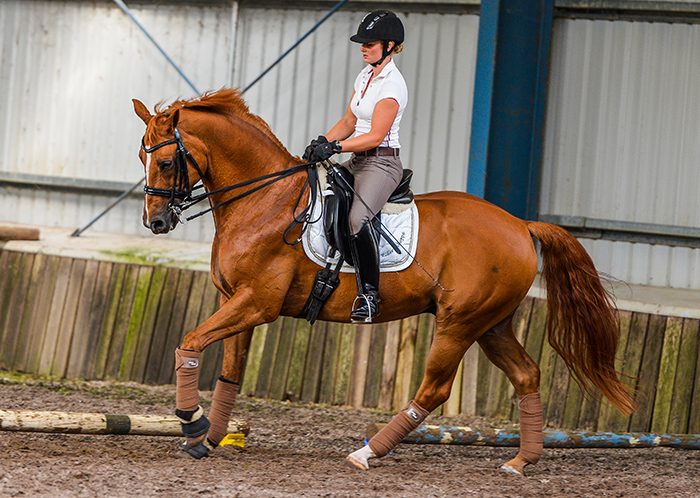
You were stressing that it was important to get the canter transition correct and to use both the inside leg and the outside leg…
“The inside leg and the outside leg in the end, if you don’t prepare the horse so that it accepts the leg, you always surprise the horse, and he will either over-react or not react. Then you have to use outside shoulder-in, inside shoulder-in, to make him ready. If it is a hot horse, to make it calm and accept the leg, and if it is a lazy horse to make him alive and attentive to the aids.”
You want the rider’s outside leg in position, and positioning the horse, for the transition…
“Then the last aid is the inside leg. If you forget the outside leg, the horse’s hindquarters will slip out most of the time, because the horse will be surprised by the rider’s legs. It is the same like the flying change. If you can do a good canter strike-off, you can do good flying changes, it is the same thing. Your inside and your outside leg are on the horse before the change, the outside leg of the canter will be the inside leg of the change and the outside leg of the change asks before the change and then it will not surprise the horse and the horse will change straight and the horse won’t swing. He will let you open the neck in the change, and the change will be nice and through and straight. Once the horse accepts this, he changes perfect, no problem.”
It was nice the work with Elliot’s horse because he has the tendency to be…
“A little short – and it is very important to lengthen the necks. If you don’t lengthen the neck, you block the back. For me long and round, but round is one thing, another is behind my hands. Round is always in front of me, not behind me – behind me, I don’t understand. The horse has to be round and in front for me.”
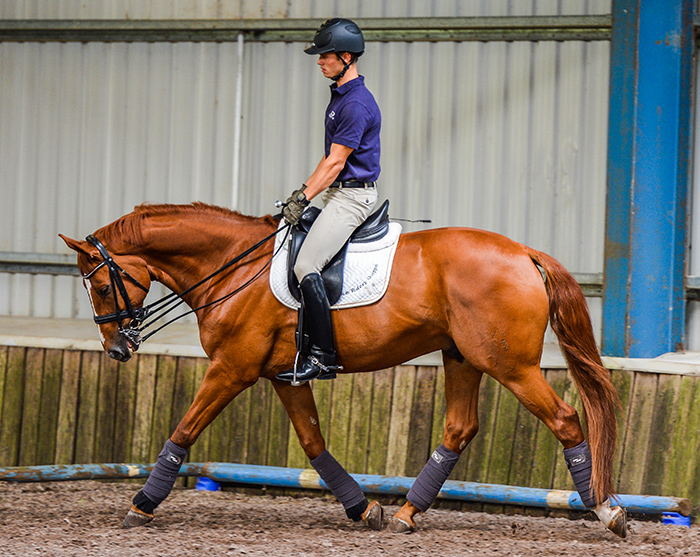
Is there any more a Spanish style of riding, or now is it a universal dressage style?
“Dressage is universal. Every horse is a little bit different, but if you study very deep, the horses have the same problems, doesn’t matter if they are Warmblood or Spanish or Lusitano, they have the same problems. In my opinion you have to come back to the classical way of doing things. Of course dressage competition, the sport, demands more high quality presentation, and this demands more high quality horses. The quality of presentation has become higher and higher in the last five or six years. The riders search more not only for precision but also for something that is impressive, but we should not be confused, something that is impressive also has to be done naturally. It can impress if the horse has been well trained and he can show incredible and spectacular passage, piaffe or changes, and if he has been well trained from the beginning he can show this in a natural way.”
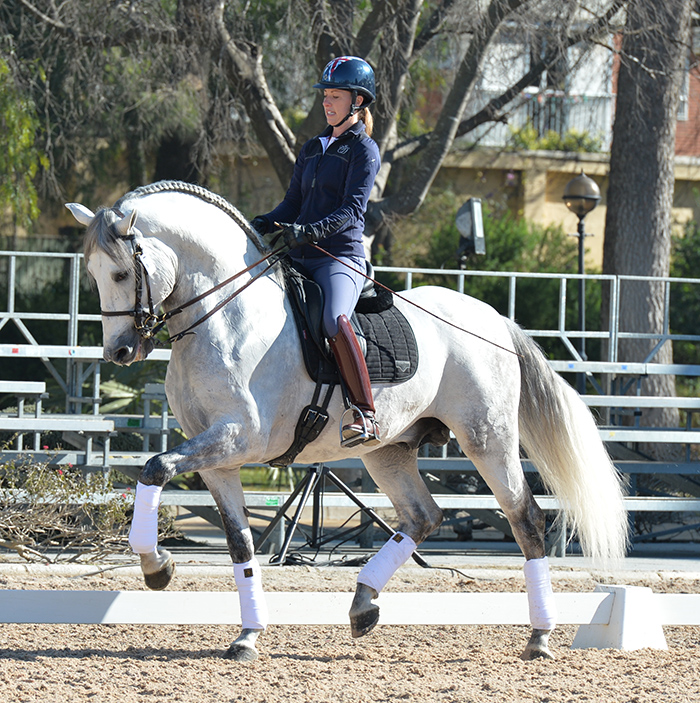
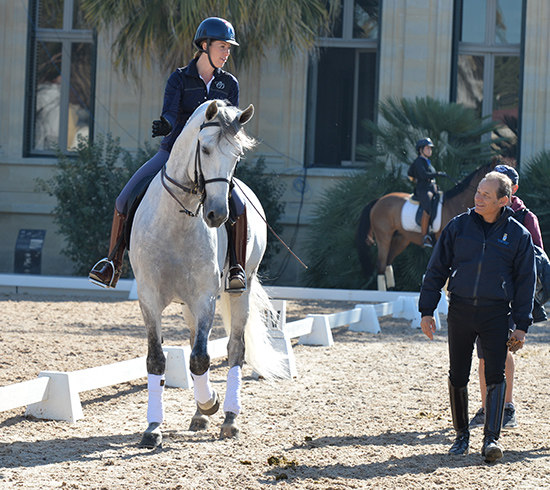
Charlotte having fun on Rafael’s Adavino in Jerez in 2016
Like Charlotte Dujardin?
“That’s it. Something which has been done in a bad way, then it will never have that natural quality. For me, this is the main thing that the judges have to look at when they consider the horses. The horses need to have expression, activity but calm and natural. Something stressed, with the rhythm too high, this is not classical.”
You were part of a group that was looking for Spanish horses with international dressage quality – was this successful?
“It is difficult to find international top horses in any breed, not every day comes a Totilas or Valegro. Where I am in my position I try as much as possible to help the riders who may have a horse with quality, and help them train the horse to make the rider proud, and make his breeding proud. Evento, Invasor, Fuego… they are top horses anywhere. We have a few horses in our School with this quality, and I have a few young riders who work with me.”
“Not everyone wants to compete – I teach in many places, this is the first time I have come so far away from home, and riders have to know about riding and training. It doesn’t matter if they want to compete or not, competing is not easy. To compete you have to be someone who can handle the pressure of the competition. The judge is looking at you, everyone is looking at you, you have to like that. But even if you are not going to compete, it is important to train in a good way because it makes the horses more healthy, more happy and the rider more satisfied. If you train properly, you can analyse the problem and find a solution without it being a problem for the horse. The only way to do that is with a basic system of riding.”
“Some of my pupils want to compete, some don’t, it doesn’t matter, what is important is that they believe in a logical system of dressage. For me, it is not so much classical as logical dressage, everything I try to explain is logical. It is natural and logical training – if they don’t have impulsion, it’s impossible. If they don’t have calm with impulsion it is also not possible. If the riders are too aggressive to the horses – again not possible. It is logic and balance… and it works.”
And it is beautiful to watch.
